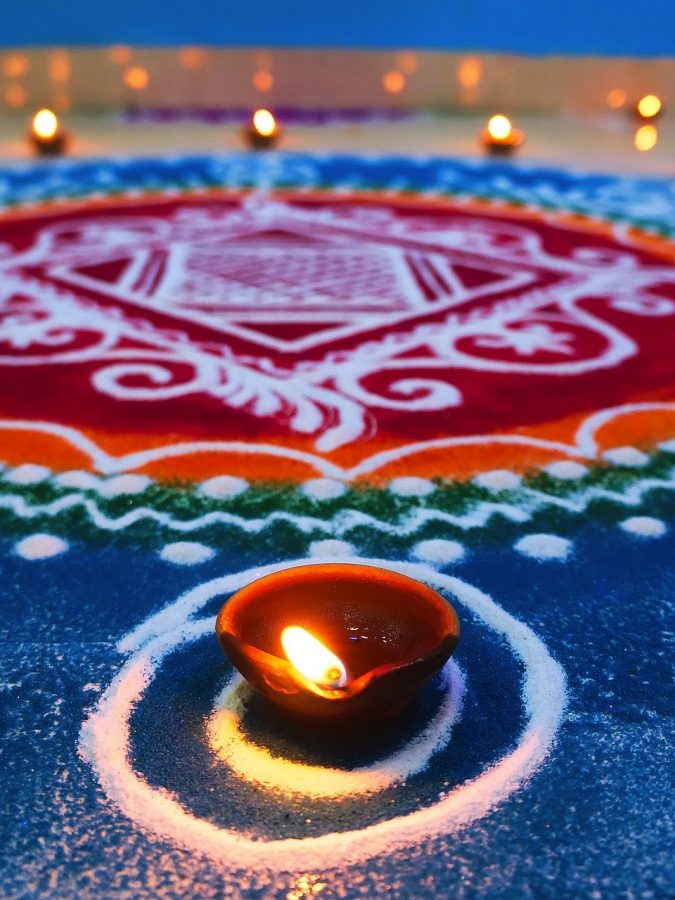Seven Lesser-Known Winter Holidays From Around the World
A diya and rangoli.
November 13, 2020
Christmas, Thanksgiving and New Years are not the only occasions to look forward to with the approaching holiday season. Countries and people all over the world have unique holidays and traditions, even if they are not as well known.
Nov. 14 is the Indian festival of lights, Diwali (pronounced duh-vaa-lee). It symbolizes triumphs like light over darkness and good over evil. This holiday celebrates Rama’s defeat of the demon king from Hindu myths, Ravana, and the rescue of Sita, Rama’s wife. Rama is a manifestation of Vishnu the preserver, the second of the three major Hindu gods. Diwali’s third day, on Nov. 14, is dominant. Dhanteras, Chhoti Diwali, Diwali, Govardhan Puja and Bhai Dooj are the five days, but they have varying names.
Day one of Diwali, Dhanteras, is when jewelry and utensils are bought because metal brings good luck. Gifts of sweets are given to wish family and friends prosperity. During Chhoti Diwali, Diwali and Govardhan Puja, gods are worshipped and oil lamps made of clay called diyas are lit. The festival concludes with Bhai Dooj, which recognizes love between brothers and sisters.
To prepare for Diwali, houses are cleaned and decorated with flowers, lights, diyas and rangolis. Rangolis are designs arranged on the floor with colored rice. According to the Times of India, “… the entire city was decked up and the people decorated the city with diyas (earthen lamps) to welcome their king.”
Time to light the menorah and spin the dreidel for the eight-day Jewish festival of lights, Hanukkah! This year, Hanukkah is from Dec. 10 through 18. One candle of the menorah is lit each night to remember the menorah that burned off of one pot of oil for eight days in the Holy Temple. The shamash, one of the nine candles, is used to light the other eight while prayers and blessings are chanted. Benji Gamarnik, a McAuliffe eighth grader, celebrates with his family. “We light candles and say prayers and then exchange gifts with each other.” The Hebrew word Hanukkah means “dedication,” and the holiday is named so because the Jews rededicated the Holy Temple to God after defeating the Greeks.
Fried foods are eaten to symbolize the jar of oil that lasted the Jews eight days. Gamarnik says that his favorite part of Hanukkah is “eating all the different foods like donuts and latkes.” The common Hanukkah game is played with a spinning top called a dreidel, and based on what symbol the dreidel lands on, money or candy is won or lost. A Hebrew letter marks each side of the four-faced dreidel, and the letters form an acronym that stands for “a great miracle happened there.” It is also traditional to give children Hanukkah gelt, or monetary gifts.
With December comes the promise of the Scandinavian festival of lights, St. Lucia Day. Killed by Romans for her religious views, St. Lucia is honored on Dec. 13 in Sweden, Norway and Finland. St. Lucia Day symbolizes the coming of the Christmas season and how there is light even in the darkest part of the year.
Norse people added St. Lucia to their winter solstice celebrations after converting to Christianity. Every town picks someone to be St. Lucia, and that person leads a parade of boys and girls dressed in white. The girls also wear lit wreaths in their hair. Eldest daughters serve their family coffee and baked goods. Traditional baked goods are saffron bread and ginger biscuits.
Dec. 16 through 24 is Las Posadas, a nine-day religious festival celebrated primarily in Mexico and other Latin American countries. Translating to “The Inns,” Las Posadas commemorates the journey made by Joseph and Mary in search of somewhere for Mary to give birth to Jesus.
A procession of dressed-up children and musicians stop at houses in their town every night to ask for shelter like Mary. They are refused lodgings, read parts of the Bible and sing carols. Mass is held every day and pinatas are broken open that are shaped like the star that led the Three Wise Men to Jesus. Tamales, bunuelos (Mexican fried dough), pozole (stew) and pambazo (Mexican white bread) are eaten.
Día de Los Reyes is a holiday similar to Las Posadas on Jan. 6. It is also known as Epiphany or Three Kings’ Day. Honoring the Three Wise Men whom Jesus received gifts from, gifts are given and King’s Cake decorated like a crown is served. Children leave out shoes and a wish list, then the Three Kings come in the night to fill them with presents.
Kwanzaa, meaning “first,” is a seven-day African American festival from Dec. 26 to Jan 1 that was created by a professor named Maulana Karenga to celebrate African culture and morals. Families participate in activities relating to the Seven Principles of Kwanzaa: unity, self-determination, collective work and responsibility, cooperative economics, purpose, creativity and faith. One of the seven candles on the Kinara is lit each night. The candles represent the Seven Principles.
At the closing of winter, on Feb. 12, is Tet Nguyen Dan, or Tet, the Vietnamese New Year, Thanksgiving, Christmas and birthday celebration all in one holiday. Tet Nguyen Dan means the “Feast of the First Morning of the First Day.” Lucky decorations include pictures of your ancestors, incense candles and lucky fruits like mango, coconut, papaya, watermelon and soursop. Soursop is a green, prickly fruit that tastes like pineapple or strawberry. Bananas are never brought into the house. Sophie Lu, a McAuliffe eighth grader, enjoys “getting vibrant lanterns and going to flower parades.”
Ao dai, or traditional long dresses, are worn, and sticky rice is eaten. Money is received from your elders in red envelopes called li xi. Lu remarks, “My favorite part of Tet is getting li xi because in Vietnamese culture when you get small amounts of money in the beginning of the year, it is supposed to bring good fortune.” Bau cua tom ca (gourd-crab-shrimp-fish), is a gambling game played during Tet with three dice. Each face on the dice has a different animal on it, and players bet on which animals will show up when the dice are rolled.
These seven winter holidays may not be as well known to all of our readers, but they are special and deserve to be celebrated and recognized.



Christine Paik • Dec 8, 2020 at 5:11 pm
Great job, Bella! Auntie is so proud!
Maleah Fennessey • Dec 1, 2020 at 9:23 am
I really loved this! I knew about a few of these, but now I know a lot more and about some other cool holidays. 🙂
Katie Arnoult • Nov 17, 2020 at 12:38 pm
Great job! I loved learning about all those different and unique holidays! 😀
Addie Bousard • Nov 16, 2020 at 12:21 pm
Great job Bella! This was super interesting and informative! It must have taken a lot of research, great job! 🙂